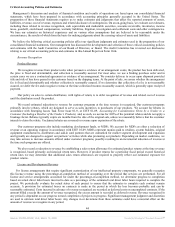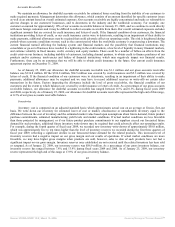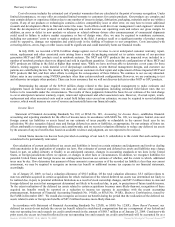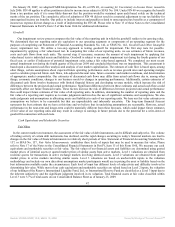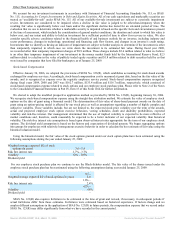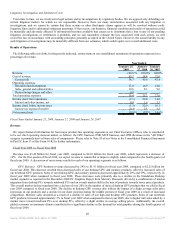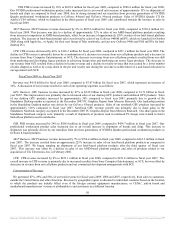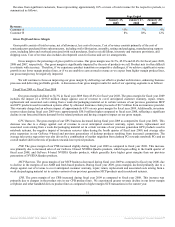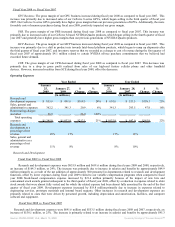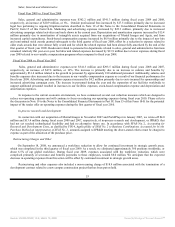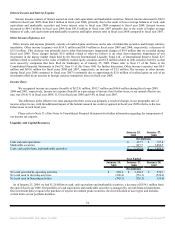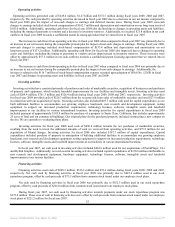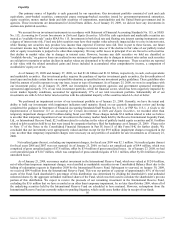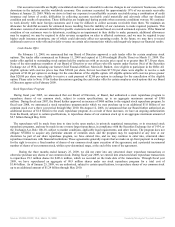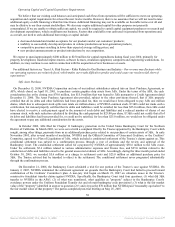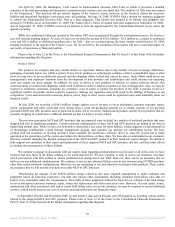NVIDIA 2009 Annual Report Download - page 63
Download and view the complete annual report
Please find page 63 of the 2009 NVIDIA annual report below. You can navigate through the pages in the report by either clicking on the pages listed below, or by using the keyword search tool below to find specific information within the annual report.
Revenue from significant customers, those representing approximately 10% or more of total revenue for the respective periods, is
summarized as follows:
Year Ended
January 25,
2009
January 27,
2008
January 28,
2007
Revenue:
Customer A 11% 7% 4%
Customer B 8% 10% 12%
Gross Profit and Gross Margin
Gross profit consists of total revenue, net of allowances, less cost of revenue. Cost of revenue consists primarily of the cost of
semiconductors purchased from subcontractors, including wafer fabrication, assembly, testing and packaging, manufacturing support
costs, including labor and overhead associated with such purchases, final test yield fallout, inventory and warranty provisions, and
shipping costs. Cost of revenue also includes development costs for license and service arrangements.
Gross margin is the percentage of gross profit to revenue. Our gross margin was 34.3%, 45.6% and 42.4% for fiscal years 2009,
2008 and 2007, respectively. Our gross margin is significantly impacted by the mix of products we sell. Product mix is often difficult
to estimate with accuracy. Therefore, if we experience product transition or competitive challenges, if we achieve significant revenue
growth in our lower margin product lines, or if we are unable to earn as much revenue as we expect from higher margin product lines,
our gross margin may be negatively impacted.
We will continue to focus on improving our gross margin by delivering cost effective product architectures, enhancing business
processes and delivering profitable growth. A discussion of our gross margin results for each of our operating segments is as follows:
Fiscal Year 2009 vs. Fiscal Year 2008
Our gross margin declined to 34.3% in fiscal year 2009 from 45.6% for fiscal year 2008. The gross margin for fiscal year 2009
includes the impact of a $196.0 million charge against cost of revenue to cover anticipated customer warranty, repair, return,
replacement and associated costs arising from a weak die/packaging material set in certain versions of our previous generation MCP
and GPU products used in notebook systems offset by allocated insurance claim proceeds of $6.7 million from an insurance provider.
This warranty charge had an adverse impact of approximately 6.0% on our gross margin for fiscal year 2009. Additionally, inventory
reserves taken during fiscal year 2009 were approximately $50.0 million higher compared to fiscal year 2008, reflecting a significant
decline in our forecasted future demand for the related products and having a negative impact on our gross margin.
GPU Business. The gross margin of our GPU business decreased during fiscal year 2009 as compared to fiscal year 2008. This
decrease was due to a charge against cost of revenue to cover anticipated customer warranty, repair, return, replacement and
associated costs arising from a weak die/packaging material set in certain versions of our previous generation GPU products used in
notebook systems, the negative impact of inventory reserves taken during the fourth quarter of fiscal year 2009, and average sales
price regression in our GeForce 9-based and previous generations of desktop products resulting from increased competition. The
average sales price regression was also driven by a combination of market migration from desktop PCs towards notebook PCs and an
overall market shift in the mix of products towards lower priced products.
PSB. The gross margin of our PSB increased slightly during fiscal year 2009 as compared to fiscal year 2008. This increase
was primarily due to increased sales of our GeForce 9-based NVIDIA Quadro products, which began selling in the fourth quarter of
fiscal year 2008, and GeForce 8-based NVIDIA Quadro products, which generally have higher gross margins than our previous
generations of NVIDIA Quadro products.
MCP Business. The gross margin of our MCP business decreased during fiscal year 2009 as compared to fiscal year 2008, due
to decline in the margins of our AMD and Intel-based products. During fiscal year 2009, gross margins declined primarily due to a
charge against cost of revenue to cover anticipated customer warranty, repair, return, replacement and associated costs arising from a
weak die/packaging material set in certain versions of our previous generation MCP products used in notebook systems.
CPB. The gross margin of our CPB increased during fiscal year 2009 as compared to fiscal year 2008. This increase was
primarily due to changes in the product mix in our CPB product lines. We experienced greater revenue decline in our lower margin
cell phone and other handheld devices product lines as compared to higher margin SCE transactions in the current year.
51
Source: NVIDIA CORP, 10-K, March 13, 2009 Powered by Morningstar® Document Research℠


